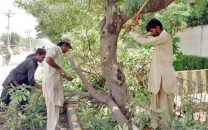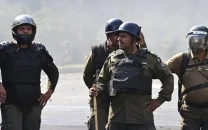Low mango produce has farmers worried for future
Annual harvest has declined by almost half according to some estimates

As the heatwaves hit the country, the advisory was to seek shade and refrain from going out during the daytime but mango harvesters were left scratching their heads as to what to do with the crop to save it from the rising mercury.
Regarded as one of Pakistan’s major fruit crops, mangoes are the direct affectees of the heatwaves that have gripped the subcontinent so far. According to some estimates 50 to 60% of the crop has taken a massive hit due to the unprecedentedly high temperatures and with the climate change induced heat waves now set to become the norm the future for mango production looks bleak for now.
“Unfortunately, the heat wave has adversely affected many crops this year, including mango and watermelon,” said Dr Anjum Ali Buttar, who is the Director General of the Punjab Department of Agriculture (Extension).
Describing the effects of the heatwave on mango produce, Dr Buttar stated: “When the temperature rises and the air gets warmer, plants release water stored in their leaves, fruits, and stems to cool down. During this natural process of plants trying to save their lives the ripe fruit suffers the most.”
The suffering of the mango crop, as per the department’s estimates stands at a 35 to 40% drop in regular annual produce.
Zahid Hussain Gardezi, who has been exporting mangoes for decades, was left devastated with how the crop turned out this time around. “I had never imagined that climate change would have such a drastic impact on our source of income.”
Gardezi’s worst fears is that since the popular Sindhri mango was deformed and smaller in size due to the rise in mercury, this would impact exports. He also thinks that the agriculture department’s estimate of fall in produce are much lower than actual numbers. “Just the produce of Langra, Anwar Ratool, Late Ratool, and Chenab Gold is down by 35%. While the produce of Sufaid Chaunsa, Summer Bahisht Chaunsa, Malda, and Azeem Chaunsa fell by 50%,” the exporter lamented.
Local farmer Amir Hayat Bhandara, who was similarly distraught with the low harvest of the king of the fruits, adding to Gardezi’s number said that Multan and Rahim Yar Khan were the worst affected as the farmers in those regions had lost out on 40 to 50% of their regular produce. While those in South Punjab will rue their losses, Dr Buttar thinks that not all farmers were in a similar position.
“Those who made better arrangements to protect the mango crop from the heat wave will be rejoicing now. Some farmers realised early on that plants would need more water during the high temperatures and acted accordingly.”
However, Bhandara was quick to counter this assessment, stating: “As always the government does not realise the host of problems we were hit with. We could have watered our crops too if there was not a shortage of water. If that was not enough pest attacks came earlier than usual as well.”
With the future looking bleak and farmers reliant on their instincts to protect crops, the Express Tribune asked Gardezi, the mango exporter, on how he would cope for the summers to come, to which he shrugged and said, “perhaps, agriculture research scientists can devise a strategy for us and the government can provide relief in some way.”
Due to recent heat wave Effect of climate change on mango production and whole punjab face shortage . Mango crop this year is severely affected because of the unusual heat wave. About 50-60% mango crop is affected by the sudden change in climate. Dusheri, Fajri and Kala Chaunsa are comparatively least affected from the heat wave, Sindhri has deformed and small sized fruits while SB Chaunsa and Sufaid Chaunsa mango varieties have been effected more due to heat wave.
Exportable fruit of Sindhri is about 20% this year due to deformity and size. Flowering of mango this year was too good, but soon flowers were severely affected as sudden rise in temperature of more than 5C between 10 – 22 March than previous years during same periods. Even the pollinators were lesser visible, later fruit drop at Marble size stage of fruit set occurred in April.
The spell of heat waves still continues in Southern Punjab Mango region. Other reasons for this catastrophe are Shortage of Canal Water, Load shedding, Shortage of Diesel fuel for irrigation and no natural relief through rain.
According to Mango Exporter Zahid Hussain Gardezi Mango crop is being more or less affected by climate change during the last couple of years, however, this year it had a very drastic impact on mango production. Production Status of varieties are following. Dusehri, Fajri and Kala Chaunsa are least effected. Sindhri is smaller in size and deformed fruit, giving lesser choice for exportable fruit.


















COMMENTS
Comments are moderated and generally will be posted if they are on-topic and not abusive.
For more information, please see our Comments FAQ